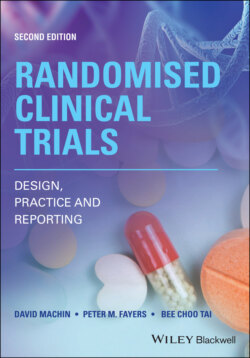Читать книгу Randomised Clinical Trials - David Machin - Страница 47
2.2 The research question
ОглавлениеOf fundamental importance before embarking on a clinical trial is to identify the research question(s) of interest. Such questions may range from a very scientifically orientated objective to one focussed on a very practical day‐to‐day clinical situation. For instance, the trial of Example 1.11 aims to reduce the number of hip fractures in elderly residents of nursing homes, whereas one objective of those reported in Example 1.1 is concerned with gastric emptying times and is similar to a non‐clinical laboratory‐based investigation.
Two key issues are as follows: Is the question worth answering? Is the answer already known? Clearly, the answer to the first should be unequivocally a ‘Yes’. For the second, one might expect a ‘No’, although there are circumstances when an earlier result may need confirmation. For example, Wee, Tan, Tai, et al. (2005) conducted a confirmatory trial of one previously conducted by Al‐Sarraf, Pajak, Cooper, et al. (1990). The rationale for the repeat trial was based on the former trial involving mainly Caucasian patients, whilst the repeat was to involve those of predominantly Chinese ethnicity and to be conducted by different investigators in another part of the world. In the event, the advantage to chemo‐radiation as compared to radiotherapy alone in terms of overall survival of patients with advanced nasopharyngeal cancer was confirmed thereby indicating wider generalisation of the results from the two trials.
The question(s) posed must have important consequences in that the answer should inform research and/or influence clinical practice in a meaningful way. Further, before the trial is conducted, there should be a reasonable expectation that the trial question will be answered otherwise, for example, patients may be subjected to unnecessary investigation and possibly discomfort without justification. One exception to this condition may be when considering information from necessarily small randomised trials in truly rare diseases or conditions where patient numbers will be insufficient for the usual rules for trial size determination to be applied. We return to this latter issue in Chapter 20.
Erbel, Di Mario, Bartunek, et al. (2007), see Example 1.12, state in the summary of their trial that:
Coronary stents improve immediate and late results of balloon angioplasty by tacking dissections and preventing wall recoil. These goals are achieved within weeks after angioplasty, but with current technology stents permanently remain in the artery, with many limitations including the need for long‐term antiplatelet treatment to avoid thrombosis.
This provides a clear rationale for testing a stent for coronary scaffolding made from a bioabsorbable material which should provide an effective scaffold but would not be permanently retained in the artery.
Meyer, Warnke, Bender and Mülhauser (2003), Example 1.11, point out that hip fractures in the elderly are a major cause of disability and functional impairment so that reducing their incidence by encouraging the use of hip protectors within nursing homes may help to reduce this morbidity.
The use of homoeopathic remedies is widespread although there have been few randomised trials to establish their relative efficacy against conventional methods (including placebo). Consequently, the trial of Example 1.4 by Stevinson, Devaraj, Fountain‐Barber, et al. (2003) compares daily homoeopathic arnica against placebo in patients with carpal tunnel syndrome having elective surgery, as it has been claimed that:
Homeopathic arnica is widely believed to control bruising, reduce swelling and promote recovery after local trauma: ….
At least to the investigators and also the corresponding journal editors and peer reviewers, these trials address important questions. The results of the trials suggest that the bioabsorbable magnesium stent is a useful development, encouraging the use of hip protectors reduces hip fracture rates, whereas homoeopathic arnica appears to be no better than placebo.
